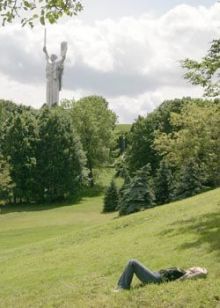While European countries struggle for an ecological balance and protect their existing greenery, Ukraine, in particular its capital, goes the opposite way. Kyiv’s parks and public gardens are under the threat of destruction. It concerns almost 400 hectares of green zones in the downtown and about 3,500 hectares of the city’s forests. If the Kyiv Council approves the new development plan of the city till 2025, new buildings will appear there instead of green plantations. This is what disturbs the specialists of the National Ecological Center of Ukraine and the charitable foundation “Kyiv landscape initiative,” which analyzed the new concept of the development plan and lodged an appeal to the ministry of regional development and building. According to the ecologists’ conclusions, the new plan legitimizes building over parks and public gardens, so Kyiv residents soon can forget about having a rest there.
One can obtain more detailed information about the new project for Kyiv’s development at the website (grad.gov.ua) of the municipal utility enterprise “Center for city planning and architecture,” said the main designer of the plan. It also mentions that everyone can join a discussion about the development plan at a special forum or visit a public hearing, which will take place on June 15. As ecologists informed, first the hearing was appointed for the beginning of the month, and then the “Center for city planning and architecture” canceled it (perhaps after learning about the claim of ecologists to the ministry of regional development and building), and now set a new date. However, will this date remain unchanged and will the Center take into account all the concerns and wishes of its citizens?
“There are no formal reasons for a development plan from 2010 to 2025, as the current development plan is designed till 2020,” pointed out the expert of the charitable foundation “Kyiv landscape initiative,” and co-author of the current development plan Serhii DIUZHEV. “They want to adopt a new concept because the current one is allegedly outdated and falls behind the dynamic changes the city experienced. The main content of the new concept is reduced to one statement: all future city planning will be done exceptionally on free territories which are now accepted and distributed by the Kyiv Council. According to the law, the development plan is the key document of city development, and if the new one is adopted, you can say goodbye to Zhukov Island, Koncha Zaspa, Pushcha Vodytsia, Feofania, the Protasiv Ravine, Solomiansky Park, Druzhby Narodiv Park and so on. One needs a professional approach to adopt a new development plan. But this document is elaborated only to keep up appearances, it doesn’t contain any scientific or professional arguments.”
Ecologists say it is impossible to retain the status of a green city under such conditions. According to the state building norms, there should be 20 square meters of green zones for public use (i.e. parks and public gardens) per permanent resident. But already in 2002 this figure was 16.5 square meters. At present, according to the calculations of the National ecological center of Ukraine, this figure decreased to 14 square meters per resident.
“We like the current development plan because it doesn’t harm any parks or public gardens in Kyiv. In particular, it doesn’t plan building over green zones,” said deputy director of the National Ecological Center of Ukraine Oleksii VASYLIUK. “But after 2002, when a building boom started in Kyiv (which reached its high at the end of 2005) a colossal quantity of green zones was replaced by buildings. So there are state building norms, city planning legislation, which excludes building at the expense of green zones, but it is violated. And the Kyiv Council wants to legitimize precisely these violations in the new development plan. 400 hectares of green zones – according to our calculations, that is an approximate area of planned construction, but we don’t have all the decisions of the Kyiv Council about allotting land for construction. The new concept of the development plan presupposes increasing green zones up to 20 square meters per resident, but there is nothing said about how they are going to achieve it. Perhaps by means of demolishing new buildings, though this is hardly realistic.”
Now ecologists hope for publicity and the support of the ministry of regional development and building. If the case reaches courts, ecologists are ready to defend their position there as well. The green future of the capital is at stake.







